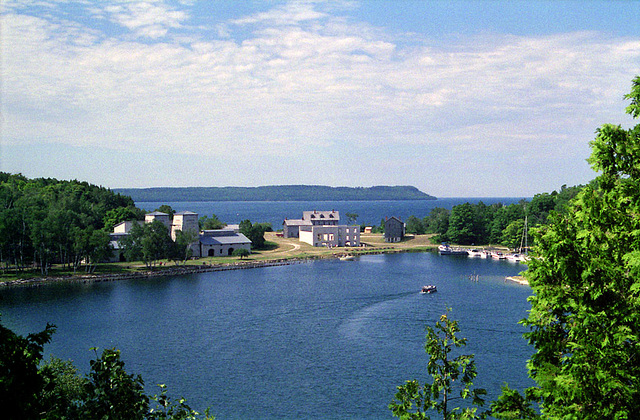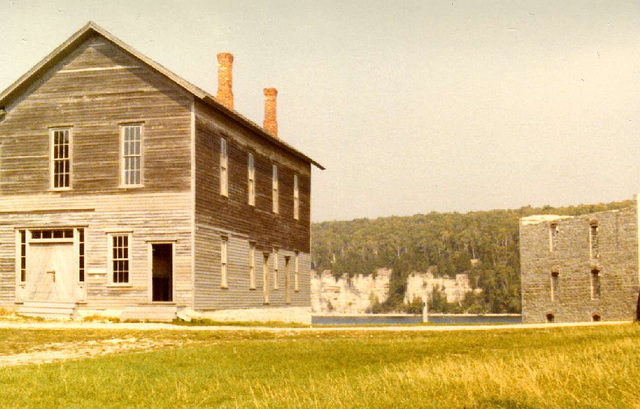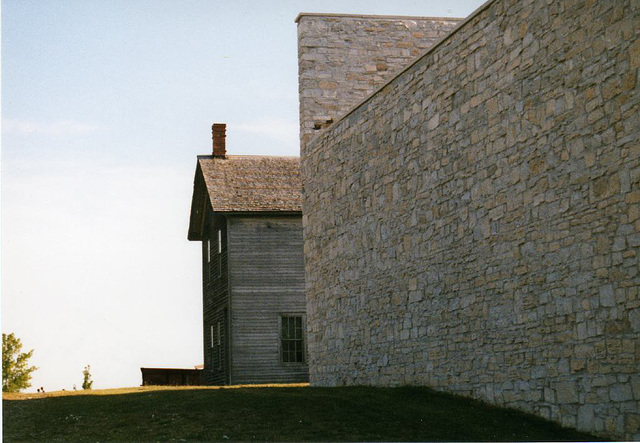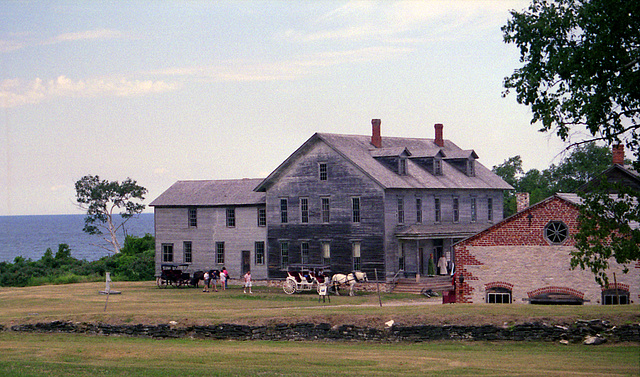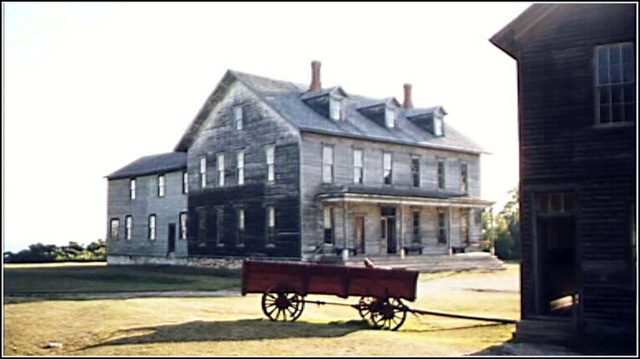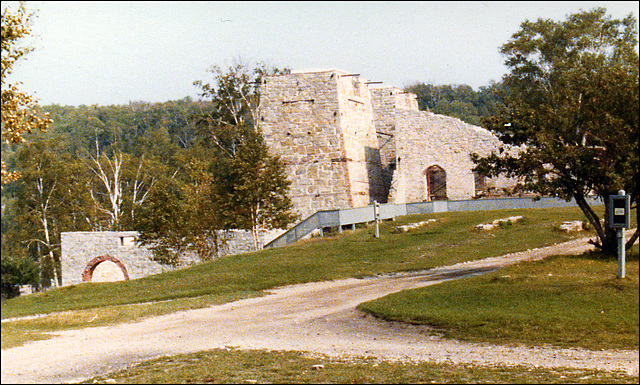
Fayette
Fayette is a state park at the north end of Lake Michigan. It was originally constructed by the Jackson Iron Company in 1867 for the purpose of smelting iron ore. Jackson Mining abandoned the town in 1891. Since that time it's been a tourist destination--a ghost town of sorts, but never completely empty....
The Perfect Ghost Town
Fayette State Park , Garden Peninsula, Michigan. Fayette's at the north end of Lake Michigan, across Big Bay de Noc from Escanaba and really not far from Green Bay.
That's Snail Shell Harbor in the foreground. I've labelled some of the buildings with notes. Taken from the trail atop the limestone cliffs .
Camera: Nikon N90s. June, 1998.
Fayette
We're back in Fayette. Here (again) are the company store (on the left), the opera house/town hall (on the right)--and the hotel!
When Fayette was an active town--mostly in the 1870s and 1880s--these buildings constituted the bulk of the Fayette "business district." The skilled tradesmen lived out on the peninsula (to the right), while general labor lived near the blast furnace (to the left). Everyone shopped at the store, and met for entertainment and governmental functions at town hall. The hotel--called the Shelton House--was both a boarding house and a host for visitors.
For over a century, now, Fayette's been a tourist destination--a ghost town--and these buildings have survived largely because of formal and informal preservation efforts. A beautiful and attractive place which happens to be a significant historical artifact.
The reason there's no background for this photo is that the buildings are on a relatively skinny spit of land. The photo was shot in June of 1981 from near the superintendent's home.
Opera House (Town Hall)
Still another picture of Fayette's Opera House and the Company Store, with the limestone cliff that defines Snail Shell Harbor visible in the background. This picture dates from the early eighties; perhaps 1981, but I think a couple years later.
"Opera House." Hmmm. It would be better styled a community hall, near as I can tell; the town government (such as it was) lived in this building, as did one or more businesses. The second floor's a meeting room, where (among other things) visiting entertainers put on their shows. I call it the Opera House because the state park did when I started visiting the town; I'm not sure whether the residents shared the conceit.
Camera: Minolta Zoom 110 SLR
Fayette Store & Opera House
Another Upper Peninsula State Park. Fayette's Michigan's best ghost town; just an incredibly photogenic place, built around a reasonably intact charcoal blast furnace complex. Photo taken in June of 1998.
The stone building in the foreground is the ruin of the company store and warehouse. The wooden structure served, among other things, as town hall and opera house.
Camera: Nikon N90s
Blessing
Fayette State Park, Michigan, 1998.
The grey building was the Sheldon House when Fayette was an active town, and the limestone and brick building in the foreground was the machine shop.
The Garden Peninsula's residents include a number of commercial fishermen, and Escanaba's Bishop comes by early in the summer to bless the fishing fleet. That's the event we're watching develop in this photograph.
This picture works quite well in black and white, by the way; along with the horse-drawn carriages, it has an apparent authenticity which seems quite impressive. Perhaps I'll post that version, too....
Scanned from a negative; taken with my Nikon N90s
Hotel at Fayette
Fayette State Park, at the north end of Lake Michigan, is a preserved ghost town. It was built by the Jackson Mining Company in the 1870s to run a blast furnace. Those ruins still dominate the view, though they've been improved since I first visited the place around 1980.
The townsite's a spectacular setting, and has been a tourist attraction for over a century--far longer than it was a functioning village.
Fayette was a company town, with all the structures owned by the mining company. This was the hotel/boarding house. The main reason the blown-out background has no details whatever is that Lake Michigan's close behind the hotel.
=====================================
Photo taken in 1998, I think, using a Minolta point-n-shoot.
I've heard Tom Friggens of the Michigan Historical Center insist that Fayette's never been a ghost town, as the place has always been occupied by someone. I regard that as a mere technicality.
Blast Furnace
Fayette State Park's most important artifact, in 1981. Lake Michigan in the background.
Fayette's Blast Furnace
Fayette State Park, Michigan, in 1981.
The owners of Negaunee's Jackson Mine had a notion that it would be more profitable to manufacture pig iron in the Upper Peninsula than to ship the unprocessed ore down the Lakes. So they scouted around and found a suitable location on Snail Shell Harbor at the north end of Lake Michigan.
This structure, the core of the Fayette operation, was a blast furnace. The furnace was intermittently active from 1867 to 1891, then was abandoned. For well over a century, now, the ruin's been the heart of a ghost town. A surprisingly well-preserved ghost town, actually, as long before it became a state park this village was a tourist attraction.
The furnace was getting major restoration when I began visiting in the late 1970s, but by 1981 they'd restored the stacks and stabilized the deterioration in the rest of the structure.
Saltboxes
Another photo from our 1981 visit to Fayette State Park.
Fayette's housing, like most places, was segregated by class. The laborers lived on the hill beyond the blast furnace, which can't have been a really desirable location. None of those dwellings seem to have survived.
White collar, technical, and supervisory staff lived out on the peninsula across the bay from the blast. Most of those folks lived in houses like these, several of which did survive. Note, though, that the survival involved lots of work; one extensive round of maintenance was, as you can see, occurring during our 1981 visit.
Jump to top
RSS feed- Latest items - Subscribe to the latest items added to this album
- ipernity © 2007-2024
- Help & Contact
|
Club news
|
About ipernity
|
History |
ipernity Club & Prices |
Guide of good conduct
Donate | Group guidelines | Privacy policy | Terms of use | Statutes | In memoria -
Facebook
Twitter

